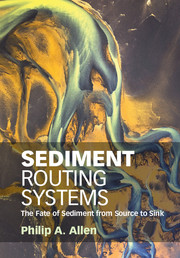Book contents
- Frontmatter
- Contents
- Preface
- Part I A Global View of Sediment Routing Systems
- Part II The Segments of Sediment Routing Systems
- Part III The Functioning of Sediment Routing Systems
- Part IV The Stratigraphic Record of Sediment Routing Systems
- 9 Sediment Production, Evolution and Provenance
- 10 Sediment Routing Systems and Sequence Stratigraphy
- References
- Index
9 - Sediment Production, Evolution and Provenance
from Part IV - The Stratigraphic Record of Sediment Routing Systems
Published online by Cambridge University Press: 03 October 2017
- Frontmatter
- Contents
- Preface
- Part I A Global View of Sediment Routing Systems
- Part II The Segments of Sediment Routing Systems
- Part III The Functioning of Sediment Routing Systems
- Part IV The Stratigraphic Record of Sediment Routing Systems
- 9 Sediment Production, Evolution and Provenance
- 10 Sediment Routing Systems and Sequence Stratigraphy
- References
- Index
Summary
The Formation of Sediment
There is a complex web of processes affecting the generation of sediment from bedrock weathering, through transport and intermittent storage, to eventual long-term deposition in a sedimentary sink. This web of processes imparts a certain textural and compositional imprint on the final deposit, yet joined-up approaches to the pathway from source to sink are rare (Ibbeken and Schleyer, 1991). Gert Jan Weltje wrote in Weltje (2012) (p.4):
Current approaches to modelling of surface processes treat the coupled evolution of source areas and sedimentary basins in terms of bulk mass transfer only, and do not take into account compositional and textural sediment properties.
In such mass balance approaches, the generation of sediment in source regions is commonly treated as a boundary condition for sediment supply, rather than as a dynamic system in its own right. Consequently, the properties of weathering products, both texturally and compositionally, entering the sediment cascade remain poorly constrained. Rare examples of where a mass balance approach is integrated with a provenance study are taken from modern and Quaternary environments (for example, Weltje and Brommer (2011)) rather than from ancient sediment routing systems. The advantage of integrating sediment generation with Earth surface process models is that the properties of sediment entering the transport network of sediment routing systems can be predicted and parameterised under different conditions of climate and tectonics, instead of being simply treated as a volumetric or solid mass boundary condition.
The evolution of sediment involves important modifications to the original parent rock (Johnsson, 1993). Such modifications might be chemical and mechanical weathering of bedrock and regolith, or the fractionation of grains during transport. Compositional variation within a sediment routing system is due to (1) mixing of grains from different sources and (2) chemical and mechanical weathering of the grain population, which may take place during regolith formation at source, or during transport and storage en route to a depositional sink (Weltje, 2012).
Figure 9.1 illustrates a simple mixing model of a fault-bounded sedimentary basin with two catchments feeding sediment to an adjacent basin.
- Type
- Chapter
- Information
- Sediment Routing SystemsThe Fate of Sediment from Source to Sink, pp. 297 - 334Publisher: Cambridge University PressPrint publication year: 2017
- 1
- Cited by



